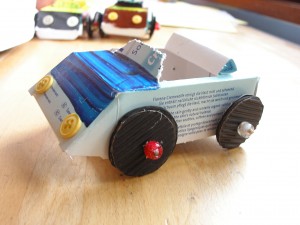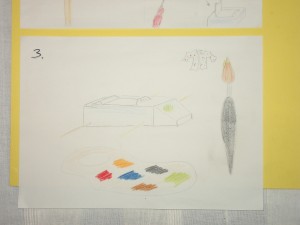by Lucy Rüttgers
The goal of the project „constructing and crafting a car from scrap material“ is to help Max (5;2) by …
- supporting him individually and adequately and
- enhancing his assimilation into the group.
Case History
Max‘ mother had attended Hanna Vock’s info session on the topic „giftedness“, and then turned to our kindergarten, because my colleagues and I were attending an IHVO-certificate course.
She told us about her son’s unhappiness at his current kindergarten. She also mentioned that the kindergarten teachers there had said they couldn’t support Max adequately, and thus encouraged a change of kindergartens.
When he joined us, he was 4;8. Acclimatization wasn’t easy for him. He had chosen 6-year-old schoolchildren as friends, who were frequenting our after school care club and therefore were only available as playmates for him in the afternoons. Within his kindergarten group he found no friends.
… it in a nutshell …
Regardless of a lack in personnel, this kindergarten teacher arranges extra time for the execution of a week-long project, with only two children, including an elaborate preparation phase. A boy (5;2) receives adequate cognitive stimulation, and by joint-project-activity comes into contact with another older child from his group.
The enormous cognitive abilities of the boy, his high motivation and great sense of joy, when handling reasonably difficult tasks, become evident.
He likes playing the „difficult“ games, preferably only with me. Each of my attempts to let other interested children join our game failed – he would eventually leave the game, either because the other children didn’t fully grasp the rules or because, according to him, they didn’t play fast enough. During an intense period of playing time, we grew rather close.
Max was very interested in letters and numbers. I assisted him in assembling a maths-folder, in which I would write problems of varying levels of difficulty for him. Yet, he preferred solving them in my presence, instead of when he was alone.
He already knew letters and often wanted to write. He would design birthday cards and the like, for example for his parents. He would dictate a text to me, which I would have to write on a sheet of paper. And then he would copy it all by himself and rather enthusiastically.
Max‘ mother told me about his interest in construction plans. So, together we would also build vehicles following LEGO construction plans.
The insufficient personnel situation in our kindergarten at that time impaired our working conditions in the way that many vital pedagogic measures were made impossible. So during that time, Max also wasn’t able to receive the support and attention he needed in my opinion.
I was in the process of leaving this kindergarten and had decided that my last project there was to help out Max.
Preparations
In order to find the right project for Max, we did the Questionnaire on Child’s Interests. Once more it became clear that he was interested in letters and arithmetic, but also in construction. We had written and calculated quite often by then, so I decided to appeal to his interest in constructing.
I knew I had to come up with something interesting to catch his attention and make him enjoy the task. And it was to be of a special and appropriate level of difficulty for Max.
I remembered his passion for construction plans and suddenly the idea of letting him construct a car with a construction plan came to my mind.
In order to facilitate his integration into the group (he is still rather lonely), I decided to let those boys join the project, whom Max had listed in the questionnaire. Each of them would get to construct their own vehicle, also helping each other throughout the process in both – defining individual tasks and putting them into practice.
The Prototype
[car1] (Click photo for larger image. Click arrow at top left to get back to original size.)
At first, I constructed a prototype (see photo), so that I could present my idea of a manufacturing method to Max. I wanted to know whether he was interested in this kind of project. He was thrilled.
He also liked the idea of inviting two of his „friends of choice“ to join the project. Unfortunately, one of them was going on holiday just around that time. The other boy, Peter, also an experienced LEGO-constructor, turned out to be rather keen on the project as well. He, too, disposes of good experience in building LEGO following a construction plan.
I then created a poster, so the children could check the materials and tools needed for the project. (See photo.)

The objects were partially glued to (e.g. corrugated cardboard, foam craft sheets, pearls, buttons, screws) and partially drawn on the poster as little sketches. The children were to manage the higher level of difficulty of having to identify the objects by way of my drawings.
However, the boys‘ independence was to be ensured, so some of the materials were glued onto this first poster. Later on, in the step-by-step instructions, they had to identify the sketches.
The step-by-step instructions
I compiled five sketches as step-by-step instructions in DIN A4-format. Max designed a sixth sketch. Due to lack of time, I only created them either one day ahead of time, or immediately before the activity. This had the advantage that I was able to adapt to the children’s working pace and avoided recurring mistakes in the instructions.
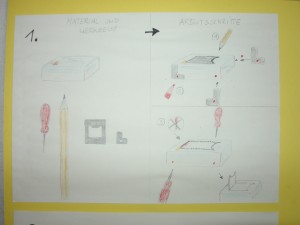
The instructions were always designed in the way that on the left side of the poster you could see the starting point of the particular construction phase, which was to be continued, as well as the necessary tools and materials for this phase. On the right, the individual steps of this construction-phase were portrayed in successive order. (Drawing these sketches was rather challenging.)
In order to support Max‘ social adjustment, I wanted them to help each other, and I tried to support their joint efforts as best I could.
First Stage of Construction
Drawing a roof, perforating and gluing accordingly. Drawing the points for the axes and inserting these.
First, we studied the materials- and tools-poster together. To make sure they had understood and identified everything correctly, they would tell me what they saw. Their levels of knowledge and comprehension complemented one another well. Peter knew the term „nut“, which Max referred to as a screw, and Max could identify the numbers next to the symbols correctly: two buttons, six beads.
Afterwards, we talked about the content of the first set of instructions. Both of them grasped the context and interrelations very well. Some of the more difficult parts of the plan were easier to understand by looking at the prototype.
Both went ahead rather enthusiastically, distinguishing and sorting out the needed parts from a pile of materials and tools. This took no time at all. The different size nuts, which were often hard to distinguish at mere eye-sight, posed a somewhat greater challenge. They needed four pieces of each size and came up with the idea of comparing them with the nuts glued onto the material-poster. They quickly had gathered them up and were keen on getting started with the construction.
So, by turning to the plan once more, we figured out the first constructional step together. We distinguished and picked the necessary materials and tools for this step from the already compiled collection. My unintentional mistake with one of the stencils was compensated by the boys without greater difficulty or unease. (I had originally chosen a stencil fitting the surface of the box, with had a cut-away in the middle, to be transferred to the box. Along this outline the box was to be perforated. By mistake, I had drawn the following steps wrong – a correction was not possible due to lack of time.)
Drawing the points for the axes was difficult. On the left side, you could use the stencil just as usual, but for the right point you had to turn it over and use the mirror-inverted side. Much to my surprise, Peter immediately noticed this and was able to implement the idea. He then helped Max to transfer his points as well.
Duration: approx. 45 minutes.
What were my observations?
Both children treated each other very politely and were very considerate of each other. Neither of them laughed at the other, if they made any mistakes or said something wrong.
Immediately after the activity, both children wanted to stay in the same room and play table-football, wanting no other children to join them. Afterwards, they also spent a long time building fantastic buildings with Kappla-construction-blocks together.
When I asked Max at the end of the day, whether he had had a good day at the kindergarten, he smiled at me, nodded and said:
„Especially constructing the car!“
Second Stage of Construction
The second stage of the construction process comprised two sets of instructions: Folding and glueing the hood, as well as painting the cardboard frame with paintbrushes in colours of individual choice.
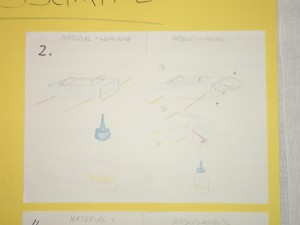
Unfortunately, I had to conduct this activity with Max alone, because Peter didn’t come to kindergarten that day. I didn’t want the project-days to be too far apart, because they were such unique highlight events for Max.
His behaviour that morning was significant. After a short morning-circle, which I couldn’t participate in, because I had a talk with some parents, the children were allowed to choose, whether they wanted to play another game in the circle or leave the circle, in order to go and do an activity. Max was the only child to leave the circle, and waiting for me so we could finally continue constructing the car.
The construction steps were rather difficult to illustrate (in a sketch), so we turned to the prototype for help and I set the corresponding impulses. The way the car was to be painted was easier to tell from the prototype.
Two of the older girls wanted to watch, what he was doing, and he agreed. They actually helped him hold the car, so he could reach the hidden corners, without smudging freshly painted parts.
Duration: approx. 40 minutes.
What were my observations?
Max’s anticipation preceding the working phase was huge. He didn’t much mind Peter’s absence. He was obviously enjoying, having won the interest of the older girls. The collaboration of the three children was quite harmonious, even though both of the girls would rather have joined this project themselves. Since they had taken part in a previous project on letters, which was also limited to only a few children, they had no problem accepting the situation the way it was.
Third Stage of Construction
Peter is catching up with the second and third constructional steps and Max is assisting him.
Both deal with the fourth set of instructions: drawing, cutting out and glueing the wheels, respectively tyres.
Max and Peter looked at the complicated instructions on folding and glueing the hood. Max explained everything to Peter and then helped him implement the plan.
Afterwards, Peter painted his car single-handedly and full of joy and creative urge, telling us, as he was painting it, why he was painting each part in which colour. He was completely relaxed and calmly mentioned how much he enjoyed painting.
During this phase, Max accomplished to figure out the next constructional step by himself. He immediately identified the necessary materials, even though they were only displayed as sketches, as opposed to being exposed as real objects as they had been on the first poster.
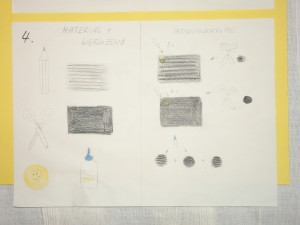
The number of circles which he was to draw onto corrugated cardboard and cut them out confused him. Why eight? he wondered. The car only has four wheels. After turning to the prototype, the answer became evident.
Max needed my assistance when drawing and cutting out the tyres because they were rather small and cutting corrugated cardboard can be quite hard. Unfortunately, again due to shortage of personnel, we couldn’t finish glueing the tyres together.
Duration: approx. 50 minutes.
What were my observations?
Both children were working in a relaxed and quiet atmosphere. They were talking to one another and were in good spirits. The effort of cutting out the tyres wasn’t exactly one of Max‘ favourite tasks.
Afterwards, both boys wanted to play table-football again, in the same room and alone. – which of course, they were allowed to!
Fourth Stage of Construction
Today it was Peter’s turn to draw and cut out the wheels, which had been Max‘ last step. He had witnessed my assisting Max and now did not need any help.
After Max had glued his tyres together, he made a drawing of the following constructional step:
Prickling the holes in the wheels and pushing them onto the axes.

In the mean time, the glue was drying, so that Max could prickle the axis-holes into his wheels immediately afterwards. This appeared to cause him some difficulty. Peter worked very consistently and single-handedly.
Duration: approx. 50 minutes.
What were my observations?
On this day again, there was also a great sense of harmony between the two boys. Max‘ idea to draw a plan for the next constructional step proved to be helpful. This way, both children were at the same stage of the construction process, and Max felt good because he could develop a plan, which Peter could use afterwards.
Fifth Stage of Construction
Now the buttons and pearls needed to be glued on as lamps, according to the instructions and the wheels had to be slipped onto the axes with washers (as illustrated in the sketch) and fastened to the car.
The children independently identified the material as well as the constructional steps.
They needed some assistance in fastening the lamps on the right side of the car. After all, the rear lights weren’t supposed to be at the front. Fastening the wheels onto the axes was more of a challenge.
Their self-reliance was undeminished despite the level of difficulty. Now only the wheel mounting had to dry.
Max came up with the idea of attaching an antenna, which both found fantastic. So did I – because it had been Max‘ idea.
Duration: approx. 45 minutes.
What were my observations?
Firstly, it was rather pleasing to see both of them wanting to play together in the Kappla-corner again after the activity. Their mood during this activity was once again rather pleasant and considerate. One could note a sense of excitement, now that the last steps of construction had been accomplished and the anticipation of the final steps and the resulting product grew.
Sixth Stage of Construction
Final assembly of the car, mutual reflection of the project and documentation of the results with a camera.
The Motivation was exuberantly high on this day, because the boys knew, they would finish their cars and be allowed to take them home. The final constructional step was the shortening of the axes (made of wooden skewers/sticks).
Afterwards, we took another look back at the initial material and tools-poster, as well as the instruction sheets of the entire project mutually. Both of them took turns talking, reporting, reflecting and remembered all the steps and events well. Both of them had enjoyed the project and wanted to do something similar again in the future.
Then we took the photos.
Duration: approx. 45 minutes.

What were my observations?
The end of the project was joyful, happy and full of emotion. Of course, I was rather happy about the positive feedback. Taking pictures was a lot of fun, because with the digital camera we could look at the photos immediately after taking them.
Final thoughts (reflection) on the project
The topic and level of difficulty of this project were just right, for both Max and Peter. This became evident time and again during the course of our mutual collaboration. Both boys‘ motivation remained high until the end. The children were able to work single-handedly during the entire project, except for a few instances.
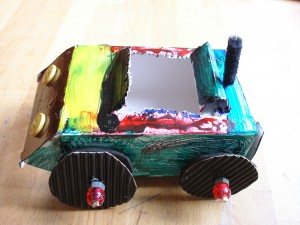
Max‘ car
My experiences concerning the making of instructional sheets: The steps need to be well prepared and intricately thought-out. Having enough time for such preparations would be helpful. Undergoing some sort of preliminary test-run with e.g. a colleague, who goes through the step-by-step constructional process and assembling a certain object, can reveal hitches. I found my sketches not exactly ideal, but rather good, if considering the prevalent conditions.
Concerning Max’s Integration
The coincidence which led to the third boy, who was originally intended to participate, not being able to take part in the project, proved to be for the better in retrospect. Often a group of three can be an unfortunate constellation because two may team up and the one left has to compete with the team.
This way, two boys found each other, at least over the course of the on-going project, and discovered their common interests (in construction). It was a joy to see them, playing together not only during the constructional phases, but also for the hours following the activities. However, this happened only when they were alone. As soon they went outside, where there were other children present, this close connection was no longer upheld.
Unfortunately, I couldn’t foster this newly established friendship any longer, because I left my position at that kindergarten a few days after. I am still quite happy to have done this project – even if it „only“ helped a lonely sad Max experience a truly splendid week in kindergarten in which he felt great for once!
See also: Plans, Drawings, Sketches, Mind-Maps.
Date of publication in German: June 2012.
Copyright © Lucy Rüttgers, see imprint
Translation: Sonia Wagner / Arno Zucknick

